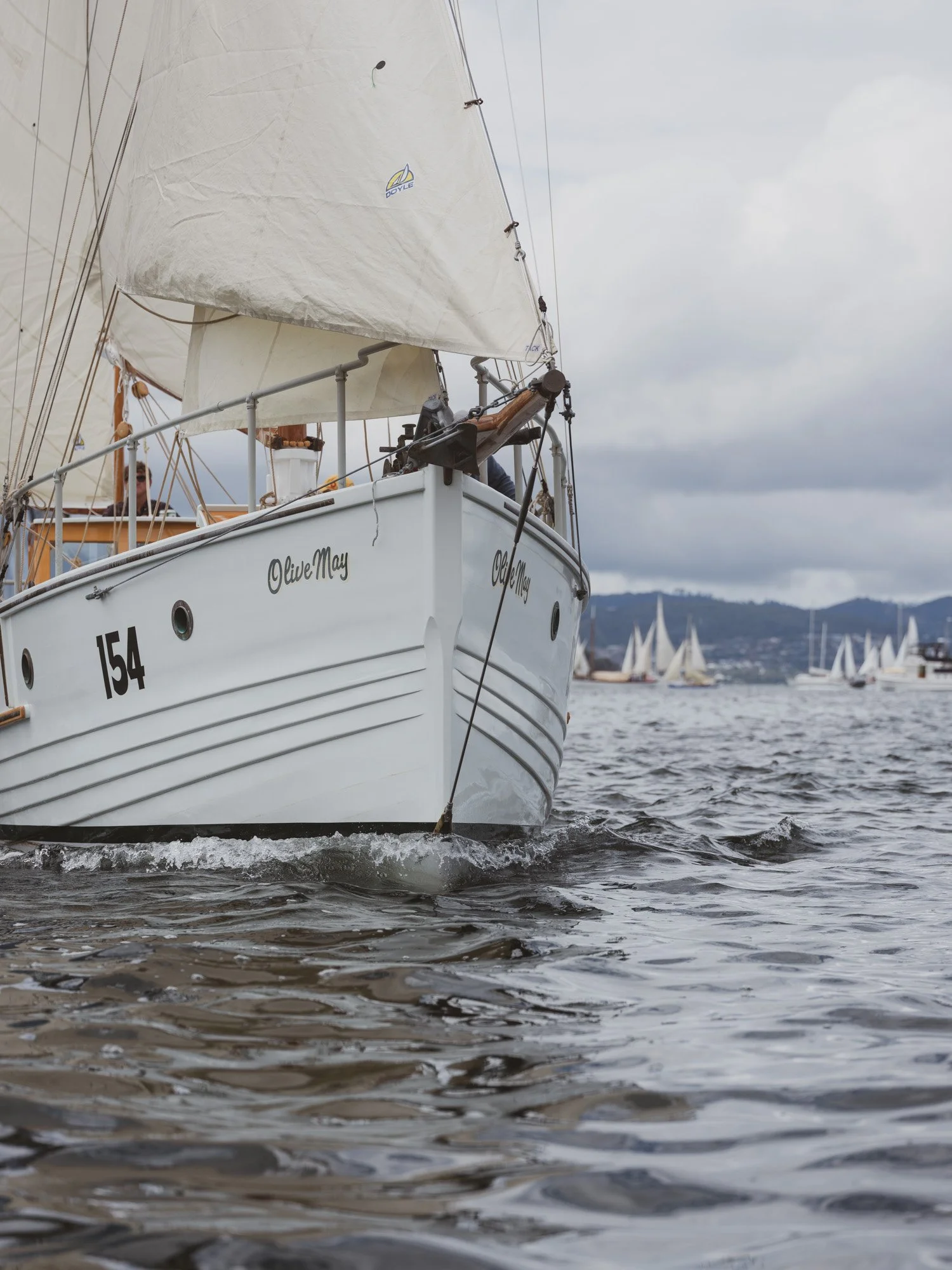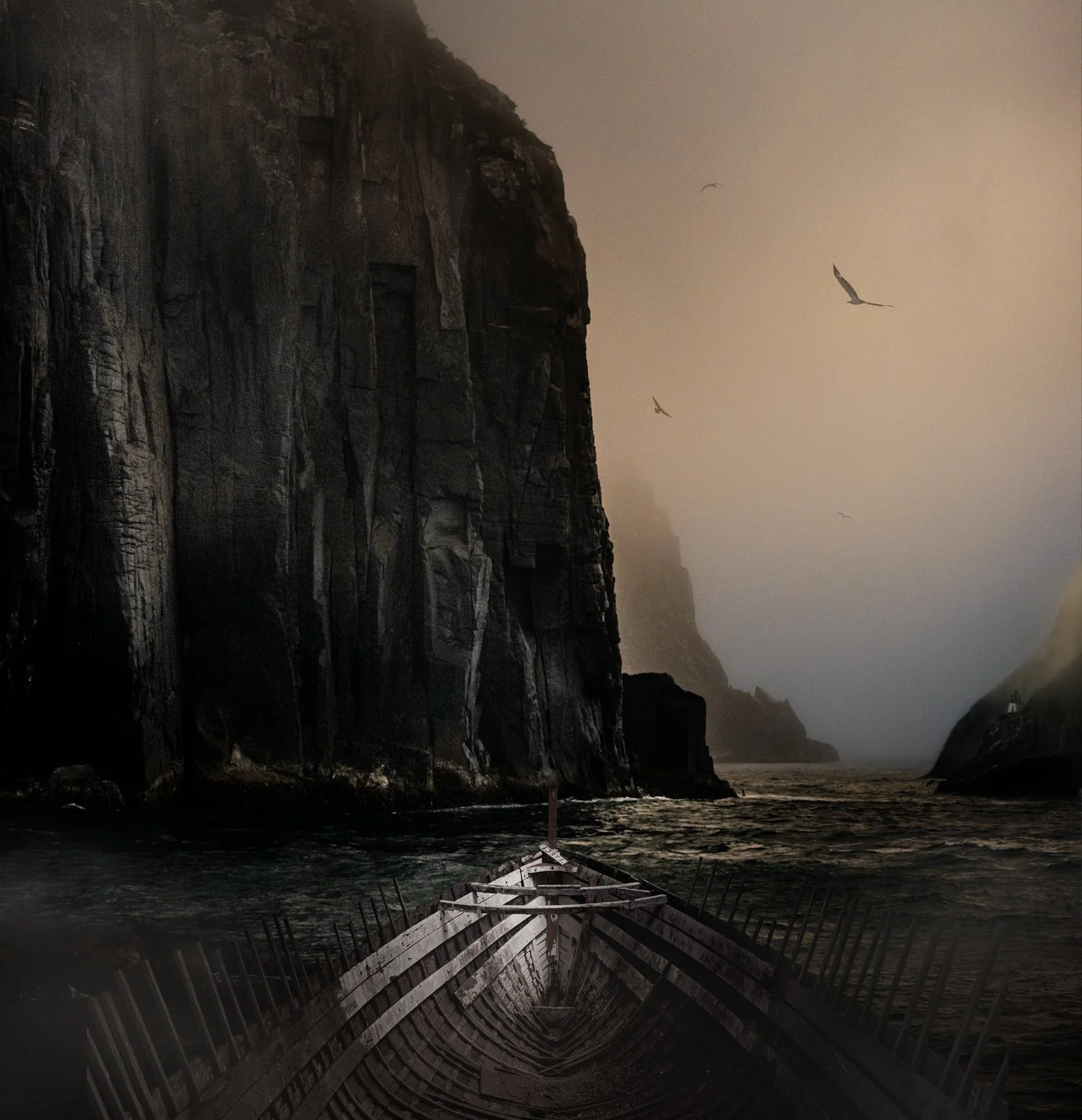Olive May’s First Passage?
By Andrew Wilson
OLIVE MAY at the 2023 AWBF
It’s taken me 2 years and 10 months to write this sentence. Though it’s not writer’s block I’m suffering from, it’s history block (if there is such a term).
Back on the 3rd of May 2020 - Sean Langman reached out via email asking, “Are you ready to start another book?! I wish to trace OLIVE MAY’s history (Sean is her current custodian) as well as the inference she was built by a convict at Port Davey. His name is Thomas Doherty.”
My previous book publications include Blue Water Classics, Coast Tasmania and the two-book series Old Sea Dogs Of Tasmania. When I released the first Sea Dogs in 2013 my father commented, “You’ve opened a can of worms here son.” That certainly proved itself to be true with crusty old mariners popping up from all around the island in the years since. However, I can honestly say that they have nothing on the worms that Sean’s email released. This clew of worms promptly wriggled themselves down into the Alice In Wonderland wormhole of history, or possibly the ALICE AND ANGUS wormhole, as you’ll discover from reading further down.
OLIVE MAY with Cray Pots aboard in the 1960’s
Over the last 2 years, I have spoken to many people associated with OLIVE MAY to try and ascertain her provenance. From descendants of convict Thomas Doherty who built the ALICE AND ANGUS in Port Davey in 1800s, to members of the Appleton family who owned the OLIVE MAY up until the mid 1980s. I’ve spoken with archivists from the Maritime Museum of Tasmania, and even Graeme Broxam who I would consider the living custodian of much of Tasmania’s maritime heritage. All have been left scratching their heads over this one.
So dear Southern Woodenboat Sailing enthusiasts, I seek your assistance with helping me solve the initial riddle of the Olive May’s first passage.Who built her, and where?
Graeme Broxham photographed by Andrew Wilson
For those not familiar with Graeme's publications, he is the author of books such as Shipwrecks of Tasmania and the recently updated - Those That Survive Volumes 1 and 2 - which was rereleased last month in collaboration with Nicole Mays. Graeme also wrote the introduction for Sea Dogs Book 1 back in 2013 and is the librarian for the Wooden Boat Guild of Tasmania.
The long-considered belief among descendants, historians and even Graeme is that the ALICE AND ANGUS was renamed the OLIVE MAY. This belief is founded on the fact that that the ALICE AND ANGUS was sold in 1902, and few months later a boat of similar size and make appeared in Triabunna named the OLIVE MAY. This was until some new documents fell under Graeme’s keen eye, “The ALICE AND ANGUS was sold in 1902, but it was renamed WHITE WINGS and was subsequently British registered when it started to fish in Bass Strait. WHITE WINGS was then renamed SENNA and was eventually shipwrecked on the Victorian coast in the late 1930s.”
These documents look to have finally called an end to the ALICE AND ANGUS/OLIVE MAY connection. Our worms on the other hand, have just decided to branch off down into a myriad of other holes, some still leading towards Thomas Doherty and the west coast.
Graeme himself had a conversation with Pat Appleton back in 1983 that provides a strong aural clue in this direction,
“A friend and I were sort of sniffing around with the idea of potentially buying the OLIVE MAY (in 1983) if we ever got jobs and some money together. I spoke to Pat Appleton myself, he reckoned the OLIVE MAY was built on the West Coast and commented that 'she’s (over) a hundred years old.' He was very proud of that fact, which in 1983 implies they (the Appletons) had an idea in their mind that this boat was built in the pre-1900s. He was also quite adamant the OLIVE MAY was built on the west coast."
As Graeme noted to me afterwards, the issue here is that we're dealing only with an aural account of history - ruing the fact that this conversation came long before he began documenting historic accounts for publishing.
But this illustrates the pinch point for this particular riddle. In the early to late 1900s small vessels built for coastal trading weren’t required to be placed on the British register, so other than the occasional newspaper entry, very few written records were kept of boats built at that time.
Graeme explains,
Before 1881, when Strahan was established, little was happening at Macquarie Harbour other than the beginnings of servicing the West Coast mining industry, little newspaper correspondence, and no reports of any boatbuilding on the scale of a vessel the size of OLIVE MAY. Port Davey, on the other hand, was basically more or less permanently occupied from the late 1830s through to the early 1880s. This is based on the residents known to be involved with the Pining industry (harvesting of Huon Pine for boat building and other uses) and supporting the Whalers that came into Port Davey as well. But there's only very erratic newspaper reporting of what was happening. There was no regular newspaper correspondence with Port Davey unless there was a newsworthy event such as a shipwreck, in which case a huge amount of information comes out in the fine detail of the accounts about who's there and what they're doing. The one major exception is that on the 7th of February in 1881 the Mercury reported that Thomas Doherty had just built a passage boat, name not stated, at Port Davey. This might be the ALICE AND AGNES, but the reported dimensions are closer to those of OLIVE MAY. So which one, if either, is it?”
Graeme’s question is potentially an exciting development, however it actually opens yet another hole in our search for OLIVE MAY’s provenance.
While we now know that Thomas Doherty did build a passage boat in 1881 in Port Davey, and one possibly of the same size as the OLIVE MAY, it doesn’t actually narrow down our search. Why? Because numerous passage boats were built all around Tasmania’s coastline at that time.
“The OLIVE MAY is absolutely typical of similar boats built here at Battery Point, or down the channel and a whole wide range of other places. There are around a hundred vessels identified as Passage Boats including the FANCY, the GERTRUDE LUCY and the LENNA, not to be mistaken for the trading ketch - an earlier one. They varied in length from between 30 to 45 feet and were usually built for the D’Entrecasteaux Channel and South Arm trades (ferrying produce back and forth from the farms in that area). They were like the five-ton-truck of their time and there were heaps of them about.”
And with no boat name mentioned in the Mercury’s article on the 7th of February 1881, we’re still left sifting through a haystack to find our needle.
So why all this bother over the history of an old wooden boat and who built her? I guess the answer is the same if you were to ask why we bother spending hours, months and years of our lives varnishing, painting, splicing and sanding. Or for the like of me, years spent photographing, writing and publishing books about wooden boats.
For certain there is a riddle here that I wish to solve, an itch I have to scratch. Underneath there is a greater purpose though, which Graeme expressed beautifully.
“It’s this whole idea of preserving maritime heritage, and how ships themselves fit in with communities and then the individual and family histories that are also tied up within that. Wooden boats, in particular, become linking elements in the much broader tapestry of the human experience. In 2010 one of my friends encouraged me to save a very historic old yacht that was in rather dire distress by name of Clara. She was a very well-known old boat as she was a rather ugly little motor sailer with this huge boxy cabin, like a big square caravan."
CLARA with her “unsympathetic” cabin
"So for better or for worse CLARA went down to the Wooden Boat Center in Franklin and after a substantial sum and much time and effort, we ended up with a fully restored 1892 yacht, which is the second oldest Tasmanian-built yacht, still floating in Tasmania.”
CLARA sailing in 1904, and then after her restoration
“We have a unique situation here where we still have boats afloat today that were built in the colonial era of Tasmania. And they've got all these stories that connect people from the past. We don't have to recreate history here, it's already here. It just needs to be saved, protected and promoted. We have so many vessels which are hanging on by the skin of their teeth, which are the last surviving example of their type. The CARTELA being the classic example of a Tasmanian-built river steamer. She is the only one left. The OLIVE MAY and the FANCY I believe are the last two Passage Boats left that we now know of. They've both got a very well-defined history. OLIVE MAY's early history is still a bit shrouded, but we know everything from 1902 onwards and that makes her very significant.”
My own personal connection to the OLIVE MAY comes through a 1973 watercolour painting of the FANCY that my parents purchased. Painted by Tasmanian artist Richard Bacon, this wonderful image has hung in my parent's home ever since I was a child.
FANCY’s hull in the shed with current and past owners holding the Painting - Helen and Peter Lindsay, Martin Wohlgemuth, Ian Hall
The similarity between this painting of the FANCY, and the OLIVE MAY as she appears today after Sean Langman’s long restoration, is obvious. They may not have been built by the same hand, but they are twins for all other purposes. As is the OLIVE MAY’s stance (in my opinion) of being the prettiest wooden boat afloat in Tasmania. There’s just something so stunning about that Carvel and Clinker combination.
So here we have the last two Tasmanian-built Passage Boats of their era. One now fully restored, floats serenely in the waters of the Huon River. While the other stands entombed in a shed awaiting a custodian to save her. So maybe this is more than just an itch I need to scratch. Maybe by discovering OLIVE MAYs first passage, the death song of the FANCY will be prevented as well.
“The Last Flight of the Fancy” by Andrew Wilson
If you can shine a light on Olive May's heritage between the 1880s and 1902, please get in touch. My pen is ready.
Andrew Wilson is a commercial photographer, author and publisher. He is also the current custodian of a 13ft King Billy clinker cray dinghy of an unknown origin that he has named LORDY MAY.
Graeme Broxam is a retired commonwealth public servant, author, publisher, and restorer of old boats. CLARA is for sale, you can view her listing here
The restored OLIVE MAY at this years AWBF (click to enlarge)















